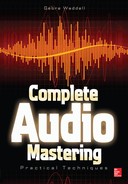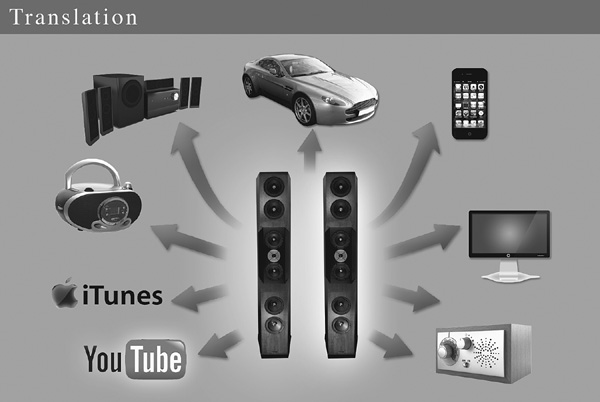CHAPTER 1
Overview of Mastering and the Typical Session
Overview of Mastering
It takes several stages of production to create the recordings we know and love. These include songwriting, recording/tracking, mixing, and mastering. Mastering, the last step, is the finalization of audio recordings and the preparation for their final medium. Where mixing involves working with individual tracks, mastering usually involves working with stereo mixes, which are just two channels, left and right. What exactly happens during mastering? There are three primary processes—equalization, compression, and limiting. Then, usually compact discs [CDs, or Disc Description Protocol (DDP) files used to manufacture CDs], MPEG-1 or MPEG-2 Audio Layer III files (more commonly known as MP3s), or Waveform Audio File Format (WAVE or, more commonly, WAV owing to its file extension) files are sent to the client. This chapter gives an overview to help you gain a good general sense of mastering.
Goals of Mastering
Once the mastering session has started, we must do what sounds best. Many mastering engineers would agree that one of the highest goals of mastering is to ensure the best translation. Translation is how a recording sounds on a variety of playback systems. We also must be sure to maximize the emotion of the recording at hand and process with musicality. Figure 1-1 shows a few of the playback systems that someone may use to listen to the final mastered recording.
FIGURE 1-1 One of the highest goals in mastering is to ensure the best translation, which is how a recording sounds on a variety of playback systems.
Role of the Mastering Engineer
Over the years, there have been many metaphors that describe mastering. One of the best compares the mastering engineer to a team owner and the mixing engineer to a team coach. The coach knows all the personalities and the strengths and weaknesses of the players. The mastering engineer is more like the team owner. He or she doesn’t know every detail, and he or she shouldn’t. Instead, the mastering engineer is looking out for the overall success of the team. The differences in perception and the variety of roles are important for creating something great.
Choose an Engineer Based on Genre?
Some mastering engineers are known for their techniques; others are known for certain genres, such as dance music, orchestral, or pop mastering. However, even the engineers known for working with a certain genre are usually just as skilled at working with all styles of music. Mastering is far less genre-specific than production or mixing.
Who Needs Mastering?
Recordings are made at so many different levels of quality. Some are created by seasoned recording engineers in amazing studios and some in small home studios. Mastering holds benefits for novice and professional productions alike. While novice productions stand to gain the most from professional mastering, almost no professional would ever go without it.
Don’t Master Your Own Mixes
Mastering is best performed by those who make it their life’s work. The world’s greatest mixing engineers, almost without exception, do not perform mastering on their own mixes. They trust their mixes only to professionals who are dedicated to mastering. Mastering is an area of specialty, and the skills simply take time to develop.
Balance of Benefit and Sacrifice
Because every process affects the entire mix, mastering virtually always involves a balance between benefit and sacrifice. High-quality mastering requires a sense of priority and seasoned judgment.
Creativity in Mastering
Creativity varies in mastering, depending on the source recording and the engineer’s tastes. Generally, professional mixing engineers tend to want more transparent processing (less creativity by the mastering engineer), whereas amateurs often want mastering to transform their sound.
Subtlety
When someone mentions mastering, subtlety comes to mind. Fine adjustments are often all that is needed when applying processing over an entire mix. As they say, a little goes a long way.
Mastering Is an Art
There is no standardized method of mastering. Professional mastering engineers have their own unique approaches and develop a personal sense of how to achieve their vision. Great mastering engineers have great taste for sound quality. Mastering engineers develop their techniques and equipment chains for years to create a sound that satisfies their tastes.
Typical Mastering Session
After quite a bit of hard work, the album’s mixes are finished up and ready for mastering. Now it’s time to choose a mastering studio. The mastering session will soon begin, and the album will be ready to release to the public. Let’s talk about what to expect as the mastering session unfolds.
The Engineer
When you first meet a mastering engineer, how do you know if he or she is good? What makes one better than another? Well, the most important factors in mastering are the skill, ears, talent, and experience of the mastering engineer. These all-important factors can be a difficult thing to gauge when choosing a service. Because of this, most people evaluate a mastering engineer by listening to their previous work.
Receiving
Professional mastering involves a client (usually an artist, producer, or mixing engineer) giving his or her recordings to a mastering engineer in person, by shipping, or via the Internet. These recordings are almost always digital files or analog tape. Usually, an order form is submitted, or the details are otherwise provided.
Attended/Unattended Sessions
Among top engineers, opinions vary about attended and unattended sessions. There is a great benefit to be had from sessions without the client being present. The mastering engineer is most familiar with his or her monitoring environment and can focus entirely on the task at hand. With attended sessions, clients may insist on changes that may be regretted later when they listen outside the studio. On the other hand, attended sessions allow for more personal communication between client and engineer and can foster the business relationship. Also, some mastering engineers view their attended sessions as a bit of a performance that clients enjoy.
Acoustics and Monitoring
So the mixes are playing and the mastering adjustments are being made. Both the speakers and the room acoustics are affecting what you hear, which of course, will affect the adjustments you make. Acoustics are the impact of a room on a sound being made inside it. In professional audio, speakers are called monitors because they allow you to monitor the sound.
Mastering is performed best in a well-designed acoustic environment with an accurate monitoring system. The acoustics should have as little impact as possible on the frequency balance. This means that sounds all across the frequency range will have a similar loudness. Accurate monitoring and acoustics allow the mastering engineer’s adjustments to translate well to the widest variety of playback systems.
Passes
Mastering engineers must listen to a recording as they make adjustments. Each time a mastering engineer listens to a song from start to finish while making adjustments, it is called a pass. A few mastering engineers price their sessions according to the number of passes they perform.
Processing
A mastering engineer uses three main tools for processing—equalization, compression, and limiting. Equalization is perhaps the most important. It is a process that affects the frequency response of a recording. For example, with equalization, the bass or treble can be raised.
Compression and limiting are dynamics processing. Basically, dynamics in the audio world describes how much loudness changes over a period of time. This may be a very short period of time, such as milliseconds, or longer, such as a second or even a minute.
Final Output
Okay, so the mastering is all done. Now what? The most common final media are a Red Book audio CD, Disc Description Protocol (DDP), MP3, and WAV.
Red Book audio CDs are made in such a way that they are ready for duplication/replication. These CDs are also called premaster CDs (PMCDs).
A DDP file is a computer file that contains all the information of a CD, including CD-Text. The DDP file can be sent electronically to a duplicator/replicator without the need for shipping.
Sometimes clients request other formats, such as MP3 files encoded from the 24-bit master or 24-bit WAV files specially prepared for Apple’s Mastered for iTunes program.
Often PQ sheets are provided, which are lists of album and track information. Error sheets are also common, which certify that CD error levels are consistent with the Red Book standard or the more stringent requirements of duplicators/replicators.

